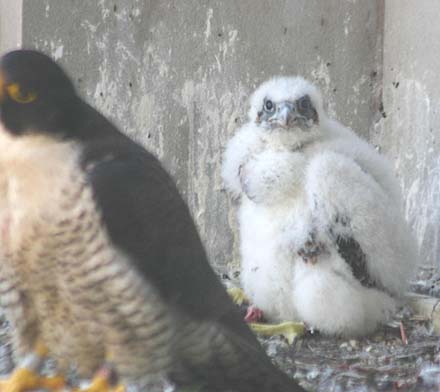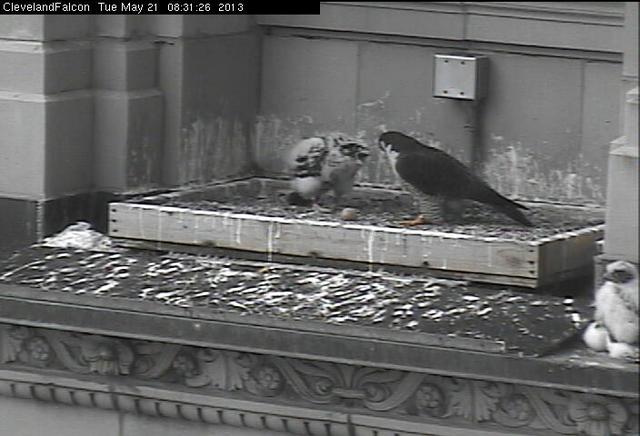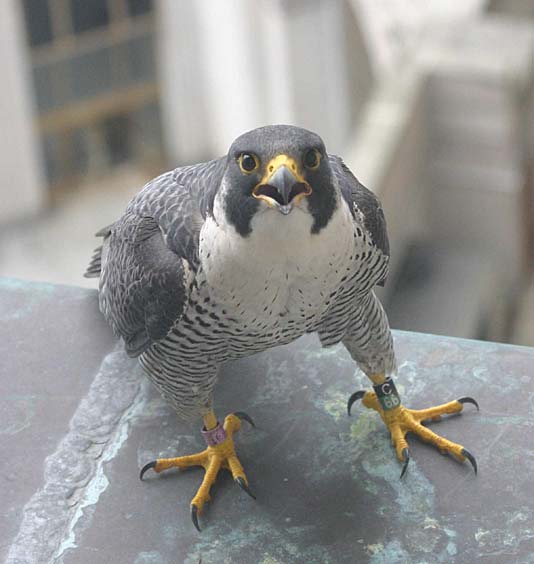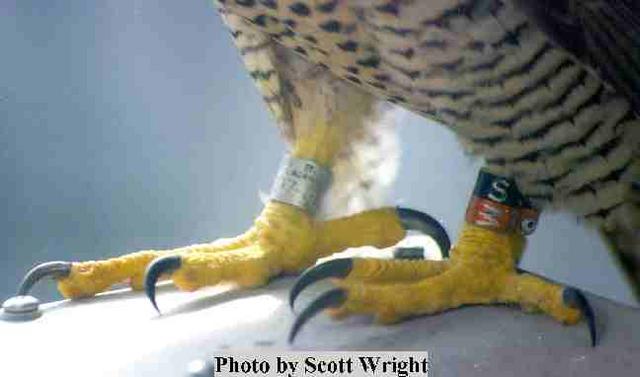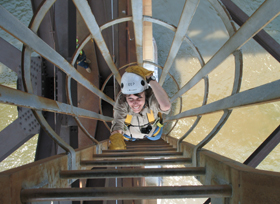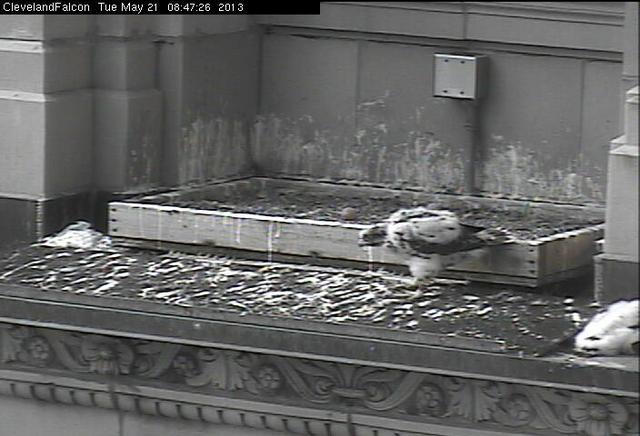FALCON FLASH
Dateline: Cleveland, Ohio
May 21, 2013
Click here to read what happened earlier
If you like computer jigsaw puzzles, here are some from this nestsite:
Thanks to special falcon fan Cecilia Hartman for creating these puzzles.
Watch the falcons live at: http://www.falconcam-cmnh.org/news.php
Our thanks to the Cleveland Museum of Natural History for sponsoring the FalconCams and for the stills.
The photo of Ms. Loucks climbing up a bridge to band chicks is courtesy of Joe Bridges. All other photos are courtesy of Scott Wright, volunteer peregrine nest monitor. They may be used in any non-commercial publication, electronic or print, but please give photo credit.
What a difference a few days make! One week after banding, Ginger and Tess are losing their down, exercising their wings, walking, and they are almost as big as their parents!
With only 2 eyasses to feed, SW and Boomer are giving them plenty to eat. Notice the full crop and real feathers.
As you know, the girls received their bands last week. The Ohio Division of Wildlife tells us: “Peregrine falcons banded in North America typically receive 2 leg bands-one on each leg. The first band is a U.S. Fish & Wildlife Service (USFWS) band which contains a number unique to that individual falcon (similar to a Social Security number). The numbers are small and hard to read unless you have the bird in hand. The color of this band can help identify the geographic region where the bird was banded. For example, USFWS bands used on Ohio falcons are purple. For birds that are hatched in the wild, the USFWS band is placed on the right leg. On falcons that were part of a release program, the USFWS band is placed on the left leg. A second band is placed on the leg opposite of the USFWS band. This band is usually one or two colors and may only have a few numbers and/or letters; these symbols are larger and repeated several times around the band.
This band is made to be read from a distance, usually using a spotting scope. The colors of this band also help identify the geographic region where the bird was banded and the symbols can be traced back to an individual bird. For example, the current color combination of Ohio color bands are a black field on top of the band and a green field on the bottom of the band. This is commonly referred to as "black over green" and written as B/G”.
Boomer was hatched in Ohio.
SW was hatched in Pittsburgh, Pennsylvania. Because Pennsylvania does not name its peregrines, we call her by her band numbers.
As you know, peregrine falcons like to nest in high places. Barbara Allen Loucks is an endangered raptor specialist with the New York Department of Environmental Conservation. Each year she bravely climbs bridges and skyscrapers to band peregrine eyasses. Here she is climbing up a bridge over the mighty Hudson River on her way to a very high nestsite.
Ms. Loucks describes what it feels like to tangle with a fierce peregrine falcon during banding at a skyscraper: “I wasn't expecting the blow to the back of my head. The adult female peregrine falcon took advantage of my back being turned and hit me hard in my helmet with her feet. I was entering the doorway going inside the top of the Kodak Tower in downtown Rochester, and had to stop for an instant, momentarily dizzy. We had just finished putting her young back in the nest box after banding, and she was demonstrating her displeasure at our intrusion”. To read an article by Ms. Loucks about her adventures banding peregrines as well as her work with peregrine falcons in general, go to:
As the two girls lose their down, it is replaced by brown juvenile feathers. Here are new wing feathers.
Watch the FalconCams closely to monitor big changes at: http://www.falconcam-cmnh.org/news.php
The girls already go out of their nest walking on the skyscraper ledge. Soon their appearance will change dramatically as they lose their down, and they will be exercising their wings by doing lots of flapping. You will also see that their parents are gone much of the time hunting in order to feed their growing youngsters.
Click here to read what happened next

